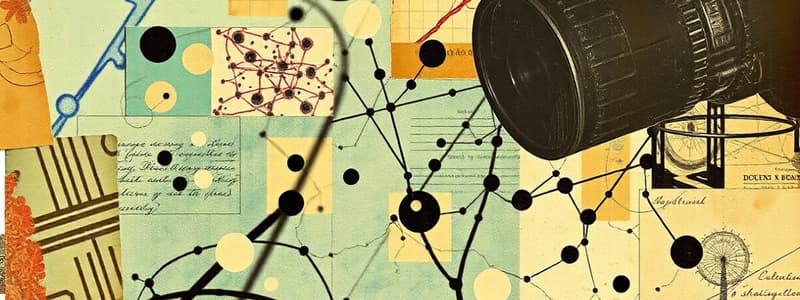Podcast
Questions and Answers
What is the primary technique used in phase contrast microscopy?
What is the primary technique used in phase contrast microscopy?
- Enhancing color in images
- Transmitting light through thick samples
- Observing specimens in their natural state (correct)
- Highlighting three-dimensional structures
Which of the following microscopy techniques is most suitable for viewing live, unaltered samples?
Which of the following microscopy techniques is most suitable for viewing live, unaltered samples?
- Phase contrast microscopy (correct)
- Fluorescent microscopy
- Brightfield microscopy
- Scanning electron microscopy
What effect does brightfield microscopy rely on to visualize samples?
What effect does brightfield microscopy rely on to visualize samples?
- Light illumination (correct)
- Fluorescent markers
- Light absorption
- Reflected light
In darkfield microscopy, what is the purpose of the opaque disc under the condenser lens?
In darkfield microscopy, what is the purpose of the opaque disc under the condenser lens?
What is the total magnification if the objective lens is 40× and the eyepiece magnification is 10×?
What is the total magnification if the objective lens is 40× and the eyepiece magnification is 10×?
Which type of microscope would likely provide the highest resolution for cellular structures?
Which type of microscope would likely provide the highest resolution for cellular structures?
Which characteristic of cells makes them difficult to see using brightfield microscopy?
Which characteristic of cells makes them difficult to see using brightfield microscopy?
What distinguishes fluorescence microscopy from other forms of microscopy?
What distinguishes fluorescence microscopy from other forms of microscopy?
Which statement about magnification in microscopy is true?
Which statement about magnification in microscopy is true?
What does darkfield microscopy primarily accomplish by using oblique light?
What does darkfield microscopy primarily accomplish by using oblique light?
Who first described fluorescence and in what year?
Who first described fluorescence and in what year?
What color do DAPI and Hoechst emit when excited by UV light?
What color do DAPI and Hoechst emit when excited by UV light?
What is the primary function of immunofluorescence?
What is the primary function of immunofluorescence?
Which microscopy technique is known for producing 3-D images?
Which microscopy technique is known for producing 3-D images?
Which statement accurately describes two-photon microscopy?
Which statement accurately describes two-photon microscopy?
What is a significant advantage of electron microscopy over optical microscopy?
What is a significant advantage of electron microscopy over optical microscopy?
What type of light is generally used in fluorescence microscopy?
What type of light is generally used in fluorescence microscopy?
What does the presence of a green fluorophore in immunofluorescence indicate?
What does the presence of a green fluorophore in immunofluorescence indicate?
Which component primarily binds to DNA in DAPI and Hoechst stains?
Which component primarily binds to DNA in DAPI and Hoechst stains?
Which microscopy technique primarily relies on electrons instead of light to create images?
Which microscopy technique primarily relies on electrons instead of light to create images?
Flashcards are hidden until you start studying
Study Notes
Microscopy
-
Cells are the fundamental building blocks of all living organisms.
-
Microscopes are crucial tools for studying the structure and function of cells.
-
Optical microscopes use visible light to illuminate and magnify specimens:
- Brightfield microscopy illuminates the sample from below, making it appear dark against a bright background.
- Darkfield microscopy uses a special condenser to illuminate the sample from the sides, creating a bright specimen against a dark background.
- Phase contrast microscopy enhances the contrast of transparent specimens by manipulating the phase of light passing through them.
- Fluorescence microscopy uses fluorescent dyes to label specific structures or molecules within the cell.
- DAPI and Hoechst are commonly used to highlight the nuclei of cells.
- Confocal microscopy uses lasers to scan the sample, creating a three-dimensional image by eliminating out-of-focus light.
- Confocal microscopy is a powerful technique for studying the structure of cells and tissues.
-
Electron microscopes use a beam of electrons to illuminate and magnify specimens:
- Transmission electron microscopy (TEM) uses electrons that pass through the specimen to create an image.
- Scanning electron microscopy (SEM) uses electrons that are scattered from the surface of the specimen to create an image.
- Electron microscopes have much higher magnification and resolution than optical microscopes, allowing the visualization of individual molecules and organelles.
Magnification
- The total magnification of a compound microscope is determined by multiplying the magnification of the objective lens by the magnification of the eyepiece.
- For example, a 10x objective lens and a 10x eyepiece would produce a total magnification of 100x.
Summary
- Optical microscopes use light to illuminate and magnify.
- Electron microscopes use electrons to illuminate and magnify.
- Electron microscopes have a higher magnification and resolution than optical microscopes.
Studying That Suits You
Use AI to generate personalized quizzes and flashcards to suit your learning preferences.




